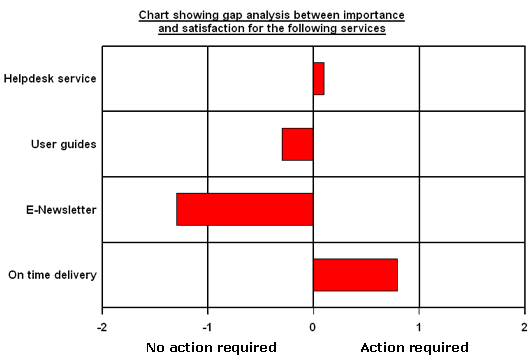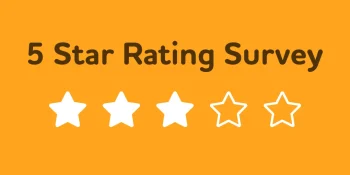What is Gap Analysis in Snap Survey Software?
Advanced survey software solutions provide the capabilities to conduct Gap Analysis. Gap Analysis shows the difference between how important attributes are to your survey respondents and how satisfied respondents are with those attributes. Gap Analysis is a useful way to compare the results from your satisfaction survey questions and importance survey questions, and allows for easy interpretation.
By comparing satisfaction and importance scores on your chart, you can use gap analysis to identify priorities for improvement.
Gap Analysis indicates that if the satisfaction bar is shorter than the importance bar, the company may be experiencing an issue! Below is an example of a Gap Analysis chart.
Interpreting the Gap Analysis Chart
A 5-point scale has been used in this survey for both satisfaction and importance ratings from 1 to 5. (1= totally dissatisfied to 5= totally satisfied) and (1= not at all important to 5 = extremely important).
The chart informs the company of how important various aspects of service are to customers, compared with how satisfied customers actually are with particular attributes (e.g. helpdesk and users guide). The gap is the mean score for the satisfaction rating subtracted from the mean score for the importance rating (e.g. Q5c-Q3c).
The table below gives an interpretation of the findings from the Gap Analysis chart. To summarize, if the mean score of a service is positive (above zero), then respondents’ rate the service as very important, but they are not satisfied with the service they are receiving. In this instance, action is required. If the gap is below zero (negative), this indicates over achievement, meaning respondents’ rate this attribute relatively unimportant, but are very satisfied with the service. In this instance no action/improvement is required.
The closer the gap is to zero, the better balance there is between importance and satisfaction.
| Type of Gap | Service | Priority | Meaning |
| Large positive gap | On-time delivery | 1 | A large, positive gap reflects respondents who think on time delivery is a very important feature, but their satisfaction of this service is low = Priority for improvement It is essential that the company look into improving their on-time delivery rates in order not to lose their customers. |
| Small positive gap | Helpdesk service | 2 | Again, respondents rated helpdesk as a relatively important feature compared to their satisfaction, but their satisfaction of this service falls short of this requirement. Again, this could be seen as an area for improvement, e.g. more helpdesk training or more staff on the helpdesk required. |
| Small negative gap | User Guides | 3 | Customers have rated this with higher satisfaction than importance. More time could therefore be spent improving other products. |
| Large negative gap | E-Newsletter | 4 | Respondents have given the E-newsletter high satisfaction scores when answering this question, but they do not think this it is an important feature. The company needs to concentrate on improving other services and products and leave the E-newsletter as low priority. |




